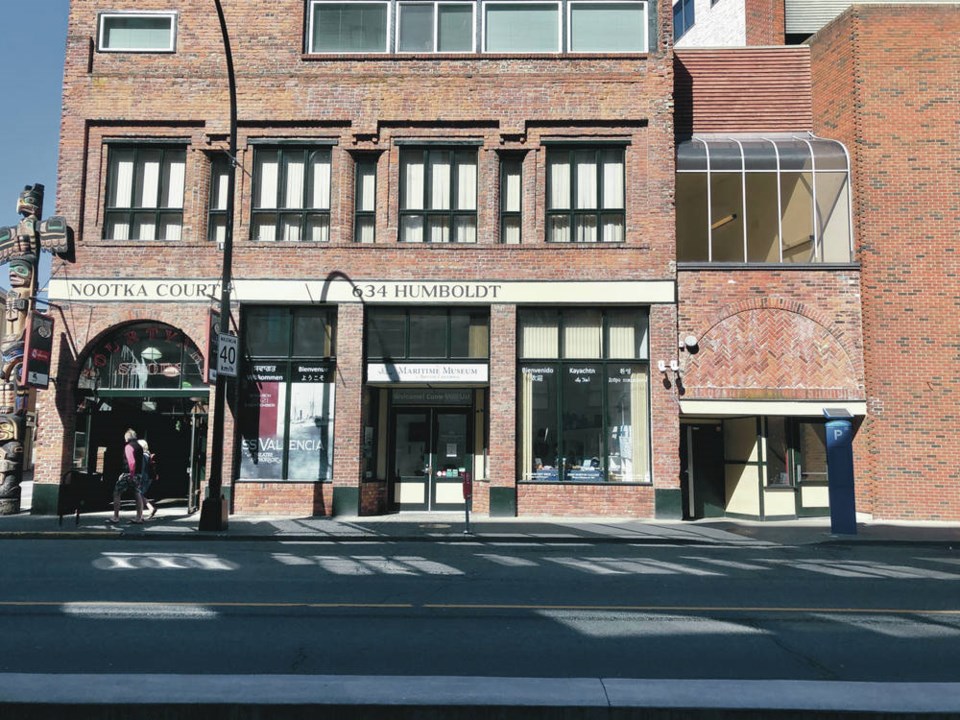With the end of the pandemic in sight, we should start looking at unfinished business — the great ideas that, for one reason or another, never got off the ground.
For example: A water taxi between Colwood’s Royal Bay and Victoria. A more suitable home for the Art Gallery of Greater Victoria. Light rail transit. And one that is long overdue: A new home for the Maritime Museum of British Columbia.
The maritime museum was housed for half a century in the former provincial courthouse in Bastion Square. It was forced to leave in 2014 because of seismic concerns.
The old courthouse, which no question is a historic gem, was never an ideal spot for the maritime museum, because the “maritime” part of the name is key. A maritime museum needs to be on the waterfront, and that waterfront will be a vital part of the museum experience.
The museum also needs to be in the downtown core. We could stretch that definition to include everything from the Capital Iron building to Ogden Point, but in reality, it should be within a five-minute walk of the Fairmont Empress, the Royal British Columbia Museum and the Parliament Buildings.
That would mean potential visitors, local and from afar, would have easy access to the museum and its impressive collection, which is considered to be the largest collection of colonial maritime history on the coast. (The total count is 35,000 historical objects.)
Since 2014, the collection has been maintained in a secure, climate-controlled facility provided by the provincial government. The maritime museum’s curatorial staff members and volunteers have continued to research and catalogue the collection while it has been out of the public eye.
The museum has a small display area at Nootka Court, close to the Empress, but space is limited; only five per cent of the collection can be displayed at any time. Staff members draw from the collection to create pop-up exhibits in temporary locations.
The waterfront in Victoria was crucial to the development of the community and the province — and that development began centuries before the first Europeans arrived on our shore.
The natural harbour was used by the Indigenous peoples whose roots here are deep. Those people were pushed aside, first from the east side of the harbour, and then from the west side as well, when the area was claimed by the government for industrial development.
Victoria’s harbour was the vital gateway when the Hudson’s Bay Company sought a location for a fort in British territory, and again when the Fraser River gold rush brought a tsunami of eager miners and merchants here.
It was Canada’s key west coast port for many years, a distinction that lasted even after the Canadian Pacific Railway reached Vancouver. Immigrants arrived here. Soldiers heading to the Great War left from here.
There is a rich history in our harbour, and in the waters all around. That story needs to be told.
Most maritime museums around the world are on, or near, the waterfront. It is the natural location for a maritime museum.
In Victoria, the best site would be the old Canadian Pacific Steamship Terminal Building, which was built in 1924 to serve marine traffic along our coast. Adjacent to the Parliament Buildings, it is an ideal location for a tourist attraction.
That is why it houses the Robert Bateman Centre and a restaurant, and before that, the Royal London Wax Museum.
The building’s heritage adds to its value as the home for the maritime museum. It was built because of what was on the water, and it is fitting that it be restored to its original purpose, as a museum at least.
This would mean finding a new location for the Bateman gallery, something we would hate to see leave downtown. (And while we are at it, there must be a spot for the wax museum as well.)
It would also be important, and respectful, to provide an Indigenous perspective in the displays. The First Nations history with the harbour, and with the entire coast, has lasted for centuries and should not be forgotten or dismissed.
It is important to have a special place in modern Victoria to pay tribute to the colonial phase of our maritime history. It is every bit as important to pay tribute to those who used the harbour before first contact with Europeans.
Downtown Victoria, the heart of the entire region, needs a boost as we come out of the pandemic. The massive reset that has already started will present many opportunities for meaningful change, if we have the courage and desire to make things happen.
It’s time to think big. A proper home for the maritime museum must be on our list of priorities.



